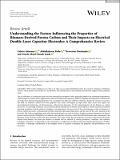| dc.description.abstract | The use of biomass as carbon precursors has been extensively investigated, with a particular emphasis on examining the properties of derived porous carbon and its application in electrical double-layer capacitors (EDLCs). Biomass-derived porous carbon-based electrodes have shown promising properties that can improve the efficiency of EDLCs. However, despite the extensive research in this field, no definitive solution has been proposed. This review investigates in depth three main factors that impact the electrochemical performance of derived porous carbon-based electrodes: (1) the initial properties of raw biomass as carbon precursors, (2) operating conditions, and (3) physicochemical properties of biomass-derived porous carbon materials. Examined operating conditions include synthesis techniques, activating agents, the mass ratio of the activating agent to the raw biomass as porous carbon precursors, carbonization/activation duration, operating temperature, and the mass of the active material in the electrode. The surface morphology and surface functional groups were used to evaluate the physicochemical properties of derived porous carbon materials. Multiple factors influence the properties of porous carbon derived from biomass and, consequently, the efficiency of the electrodes made from these materials. This study reveals that the properties of porous carbon-based electrodes derived from biomass vary from one biomass to another and are affected by various parameters, conditions, and synthesis techniques. Therefore, it is impossible to rely exclusively on a single factor to improve the electrochemical performance of EDLC electrodes. A thorough consideration of the multiple factors is required to optimize the properties and performance of the electrodes. | en_US |

